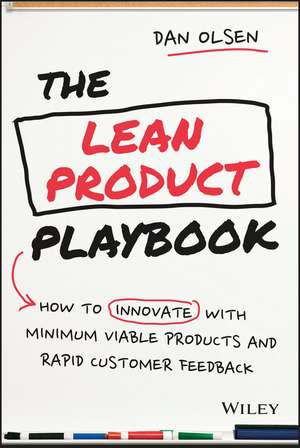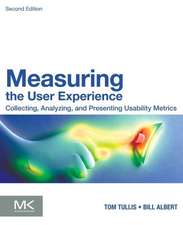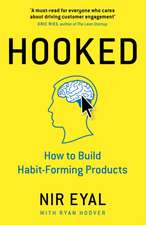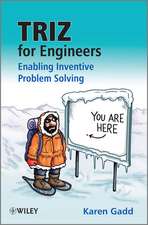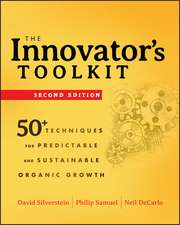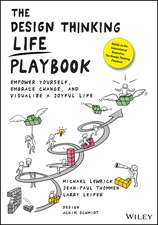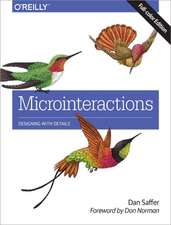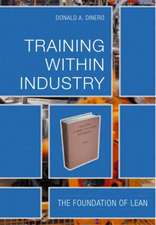The Lean Product Playbook – How to Innovate with Minimum Viable Products and Rapid Customer Feedback: Cărți product management
Autor Dan Olsenen Limba Engleză Hardback – 9 iul 2015
Preț: 188.39 lei
Nou
36.05€ • 37.19$ • 30.08£
Carte disponibilă
Livrare economică 05-19 martie
Livrare express 19-25 februarie pentru 31.91 lei
Specificații
ISBN-10: 1118960874
Pagini: 336
Dimensiuni: 162 x 235 x 31 mm
Greutate: 0.62 kg
Editura: Wiley
Seria Cărți product management
Locul publicării:Hoboken, United States
Descriere
The missing manual on how to apply Lean Startup to build products that customers loveThe Lean Product Playbook is a practical guide to building products that customers love.
Whether you work at a startup or a large, established company, we all know that building great products is hard. Most new products fail. This book helps improve your chances of building successful products through clear, step–by–step guidance and advice.
The Lean Startup movement has contributed new and valuable ideas about product development and has generated lots of excitement. However, many companies have yet to successfully adopt Lean thinking. Despite their enthusiasm and familiarity with the high–level concepts, many teams run into challenges trying to adopt Lean because they feel like they lack specific guidance on what exactly they should be doing.
If you are interested in Lean Startup principles and want to apply them to develop winning products, this book is for you. This book describes the Lean Product Process: a repeatable, easy–to–follow methodology for iterating your way to product–market fit. It walks you through how to:
- Determine your target customers
- Identify underserved customer needs
- Create a winning product strategy
- Decide on your Minimum Viable Product (MVP)
- Design your MVP prototype
- Test your MVP with customers
- Iterate rapidly to achieve product–market fit
This book was written by entrepreneur and Lean product expert Dan Olsen whose experience spans product management, UX design, coding, analytics, and marketing across a variety of products. As a hands–on consultant, he refined and applied the advice in this book as he helped many companies improve their product process and build great products. His clients include Facebook, Box, Hightail, Epocrates, and Medallia.
Entrepreneurs, executives, product managers, designers, developers, marketers, analysts and anyone who is passionate about building great products will find The Lean Product Playbook an indispensable, hands–on resource.
Textul de pe ultima copertă
THE HOW–TO GUIDE FOR CREATING PRODUCTS THAT CUSTOMERS LOVE
"If you want to create successful, innovative products that customers love, Dan′s playbook is a must–read."
Hiten Shah, Co–founder of KISSmetrics and Crazy Egg
"Dan′s product expertise was incredibly helpful in the early days of building and growing Box. I found his advice incredibly valuable and if you want to build a successful product, you will too."
Aaron Levie, CEO, Box
"A great, detailed guide on how to find product–market fit and make things people will love. This book should be required reading for everybody building products."
Laura Klein, Author of UX for Lean Startups
"Dan Olsen makes product development simple and logical. If you want to create kick–ass products, you need to read this book."
Dave McClure, Founding Partner and Troublemaker, 500 Startups
"Dan′s playbook is the missing manual on how to apply Lean Startup principles. This comprehensive, straightforward book guides you through everything you need to know to build a winning product."
Sean Ellis, CEO of Qualaroo and GrowthHackers.com
"Dan takes Lean Startup to a new level with his step–by–step playbook for creating great products! This book truly is for everyone from designers to business people to engineers."
Kaaren Hanson, VP Design, Medallia and former VP Design Innovation, Intuit
"Dan Olsen is an established Lean product black belt in Silicon Valley. His book gives product teams a simple and straightforward way to identify product–market fit, launch an MVP and then improve it systematically over time."
Ken Fine, Chief Customer Officer, Medallia
Cuprins
Introduction: Why Products Fail and How Lean Changes the Game xvii
PART I Core Concepts
Chapter 1 Achieving Product–Market Fit with the Lean Product Process 3
What Is Product–Market Fit? 3
The Product–Market Fit Pyramid 4
Quicken: from #47 to #1 7
The Lean Product Process 8
Chapter 2 Problem Space versus Solution Space 13
The Space Pen 13
Problems Define Markets 15
The What and the How 16
Outside–In Product Development 16
Should You Listen to Customers? 17
A Tale of Two Apple Features 18
Using the Solution Space to Discover the Problem Space 20
PART II The Lean Product Process
Chapter 3 Determine Your Target Customer (Step 1) 25
Fishing for Customers 25
How to Segment Your Target Market 26
Users versus Buyers 28
Technology Adoption Life Cycle 29
Personas 30
Chapter 4 Identify Underserved Customer Needs (Step 2) 37
A Customer Need by Any Other Name 37
Customer Needs Example: TurboTax 38
Customer Discovery Interviews 40
Customer Benefit Ladders 41
Hierarchies of Needs 43
The Importance versus Satisfaction Framework 45
Related Frameworks 56
Visualizing Customer Value 58
The Kano Model 63
Putting the Frameworks to Use 66
Chapter 5 Define Your Value Proposition (Step 3) 67
Strategy Means Saying No 68
Value Propositions for Search Engines 68
Not So Cuil 71
Building Your Product Value Proposition 72
Skating to Where the Puck Will Be 75
The Flip Video Camera 75
Predicting the Future with Value Propositions 75
Chapter 6 Specify Your Minimum Viable Product (MVP) Feature Set (Step 4) 77
User Stories: Features with Benefits 78
Breaking Features Down 79
Smaller Batch Sizes Are Better 79
Scoping with Story Points 80
Using Return on Investment to Prioritize 80
Deciding on Your MVP Candidate 85
Chapter 7 Create Your MVP Prototype (Step 5) 89
What Is (and Isn t) an MVP? 89
MVP Tests 90
The Matrix of MVP Tests 92
Qualitative Marketing MVP Tests 93
Quantitative Marketing MVP Tests 94
Qualitative Product MVP Tests 99
Quantitative Product MVP Tests 108
Chapter 8 Apply the Principles of Great UX Design 111
What Makes a Great UX? 111
The UX Design Iceberg 116
Conceptual Design 117
Information Architecture 120
Interaction Design 123
Visual Design 129
Design Principles 135
Copy Is Also Part of UX Design 140
The A–Team 140
UX Is in the Eye of the Beholder 141
Chapter 9 Test Your MVP with Customers (Step 6) 143
How Many Customers Should I Test With? 144
In–Person, Remote, and Unmoderated User Testing 145
How to Recruit Customers in Your Target Market 148
User Testing at Intuit 152
Ramen User Testing 153
How to Structure the User Test 155
How to Ask Good Questions 156
Ask Open versus Closed Questions 158
I Feel Your Pain 159
Wrapping Up the User Test 160
How to Capture and Synthesize User Feedback 161
Usability versus Product–Market Fit 163
Chapter 10 Iterate and Pivot to Improve Product–Market Fit 167
The Build–Measure–Learn Loop 167
The Hypothesize–Design–Test–Learn Loop 168
Iterative User Testing 170
Persevere or Pivot? 175
Chapter 11 An End–to–End Lean Product Case Study 181
MarketingReport.com 181
Step 1: Determine Your Target Customers 182
Step 2: Identify Underserved Needs 182
Step 3: Define Your Value Proposition 183
Step 4: Specify Your MVP Feature Set 185
Step 5: Create Your MVP Prototype 187
Step 6: Test Your MVP with Customers 188
Iterate and Pivot to Improve Product–Market Fit 193
Reflections 197
PART III Building and Optimizing Your Product
Chapter 12 Build Your Product Using Agile Development 201
Agile Development 201
Scrum 205
Kanban 211
Picking the Right Agile Methodology 216
Succeeding with Agile 218
Quality Assurance 222
Test–Driven Development 225
Continuous Integration 226
Continuous Deployment 227
Chapter 13 Measure Your Key Metrics 229
Analytics versus Other Learning Methods 229
Oprah versus Spock 231
User Interviews 231
Usability Testing 232
Surveys 232
Analytics and A/B Testing 235
Analytics Frameworks 236
Identify the Metric That Matters Most 240
Retention Rate 242
The Equation of Your Business 249
Achieving Profitability 255
Chapter 14 Use Analytics to Optimize Your Product and Business 259
The Lean Product Analytics Process 259
A Lean Product Analytics Case Study: Friendster 263
Optimization with A/B Testing 272
Chapter 15 Conclusion 277
Acknowledgments 283
References 285
Resources 287
Index 291
About the Author 309
Notă biografică
DAN OLSEN is an entrepreneur, consultant, and Lean product expert. He works with CEOs and product leaders to build great products and strong product teams, often as interim VP of Product. Dan′s clients include Facebook, Box, Hightail, Medallia, Financial Engines, and One Medical Group.
At Intuit, Dan led the Quicken product team to record sales and profit. He also led product management at social networking pioneer Friendster and was cofounder and CEO of TechCrunch award winner YourVersion, a personalized news startup.
A frequent speaker at business and technology events, Dan lives in Silicon Valley where he hosts the Lean Product Meetup.
For more information visit www.leanproductplaybook.com
